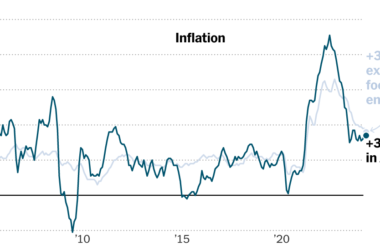A lot of states now mandate financial literacy classes for high school students, covering topics such as budgeting, saving, and managing debt.
Only seven states — Alabama, Iowa, Mississippi, Missouri, Tennessee, Utah, and Virginia — received an A grade, indicating that they require students to take a semester-long personal finance course, or its equivalent, according to a “report card” from the Center for Financial Literacy at Champlain College in Vermont. Five states got an F, meaning they have “virtually no requirements” for personal finance education in high school.
However, the report said that 23 states are expected to receive an A grade in 2028 when additional programs recently approved by state legislatures are put in place.
The surge in offerings is partly in response to the pandemic, which drew attention to precarious household finances and stark income inequality. “Things got turbocharged after the pandemic,” said John Pelletier, the center’s director. Higher inflation has also strained consumers’ budgets, and the resumption of student loan payments has renewed worries about student debt.
Concern is also growing about financial disparities among racial and ethnic groups. While about a third of American adults reported having “too much” debt, the percentage is higher — 39 percent — for Black adults, according to a large survey conducted in 2021 by the FINRA Investor Education Foundation. (The foundation — which is an arm of the Financial Industry Regulatory Authority, a nongovernment regulator that oversees brokerage firms — conducts the survey every three years.)
Black and Hispanic adults are less likely to have an emergency fund to cover three months of expenses in case of a job loss or illness, the survey found. And while about a third of adults have “high” financial knowledge, as shown by their ability to correctly answer four out of five financial questions about topics like compound interest, inflation, and risk, the percentages are much lower for Black and Hispanic adults.
Making all students take a financial literacy course can help reduce such inequality, Mr. Pelletier said.
Carly Urban, a professor of economics at Montana State University who studies financial literacy, said discussions about what topics should be taught in classrooms were often bitterly divisive, but state legislators appear to be finding common ground supporting high school financial instruction. Most American adults said they wanted their states to require a semester- or yearlong financial course to graduate from high school, according to a 2022 poll from the National Endowment for Financial Education. And most said they wished they had been required to take such a course.
Over the years, questions have arisen about whether high school financial literacy classes are effective. But recent research by Dr. Urban and others, cited in the new Champlain College report, sheds light on what works. High school financial instruction, she said, “overwhelmingly” improves credit scores, lowers loan delinquency rates, and reduces the use of risky services like payday lending. It also leads more students to low-interest college financing and away from high-interest loans and increases repayment rates for first-generation students and those from low-income families.
But a recent study she wrote with Melody Harvey, an assistant professor at the University of Wisconsin-Madison, found no impact on eventual retirement savings. Perhaps, she said, for teenagers heading to college or just entering the workforce, the idea of retiring is too distant.
“Young people may be fixated on ‘right now,’” Dr. Urban said. The study recommended that classes give priority to topics more “immediately relevant” to teenagers, like budgeting, long-term debt, and credit.
Christopher Jackson, who teaches a personal finance course to seniors at Da Vinci Communications high school, a socioeconomically and racially diverse public charter school in El Segundo, Calif., said he found that students were enthusiastic about saving in Roth individual retirement accounts once they understood the concept of compound interest and how investments grow over time.
He advises them to open Roth I.R.A.s at 18, rather than waiting until they graduate from college and start a career. One of his students has already saved $14,000, he said.
Mr. Jackson uses a curriculum from Next Gen Personal Finance, a nonprofit that pushes for teaching universal personal finance in high school, as a base for his instruction and supplements it with books on relevant topics, he said.
“You can’t play the money game if you don’t know the rules,” Mr. Jackson said. “I teach them the rules of the game.”
Sebastian Torres, 19, a 2022 graduate of Da Vinci Communications, said Mr. Jackson’s class, which includes a unit on the psychology of financial decision-making, helped him plan for both college and retirement.
“I really didn’t know about 401(k)s before Mr. Jackson spoke about it,” he said. “I 100 percent think it was worthwhile,” he said of the high school course.
The report from the Center for Financial Literacy said personal finance topics were most relevant in 11th or 12th grade, just before students begin managing their own living expenses. It recommended that students be taught these concepts shortly before they are thrust into financial independence, whether they get jobs or go to college.
Here are some questions and answers about financial literacy:
How financially literate are Americans in general?
American adults have shown a “generally poor” level of financial literacy, according to the 2023 Personal Financial Index report from the TIAA Institute and the Global Financial Literacy Excellence Center.
The report serves as an annual barometer of financial literacy in the United States. The survey asks 28 personal finance questions, including on earnings, budgets, spending, saving, investing, borrowing, managing debt, insurance, understanding risk, and finding reliable sources of information and advice.
On average, adults correctly answered about half of the index’s 28 questions in 2023, consistent with the results since 2017. Americans struggle particularly with understanding risk. The low level of financial wherewithal is “troubling,” the report said, because the index measures a “working knowledge” related to financial situations encountered in everyday life.
Improving financial literacy is important, the report said, because people with a very low level of financial savvy are more than four times as likely as those with a very high level to have difficulty making ends meet in a typical month.
Where can I test my own financial knowledge?
FINRA offers a seven-question financial literacy quiz online. Want more? Try a 10-question personal finance quiz from the Council for Economic Education.
Where can I find information on financial literacy curriculums?
Next Gen Personal Finance offers free curriculum materials and teacher instruction. Other sources include the JumpStart Coalition for Personal Financial Literacy, a nonprofit that seeks to improve financial literacy among the young; the University of Chicago Financial Education Initiative; and the Consumer Financial Protection Bureau.








